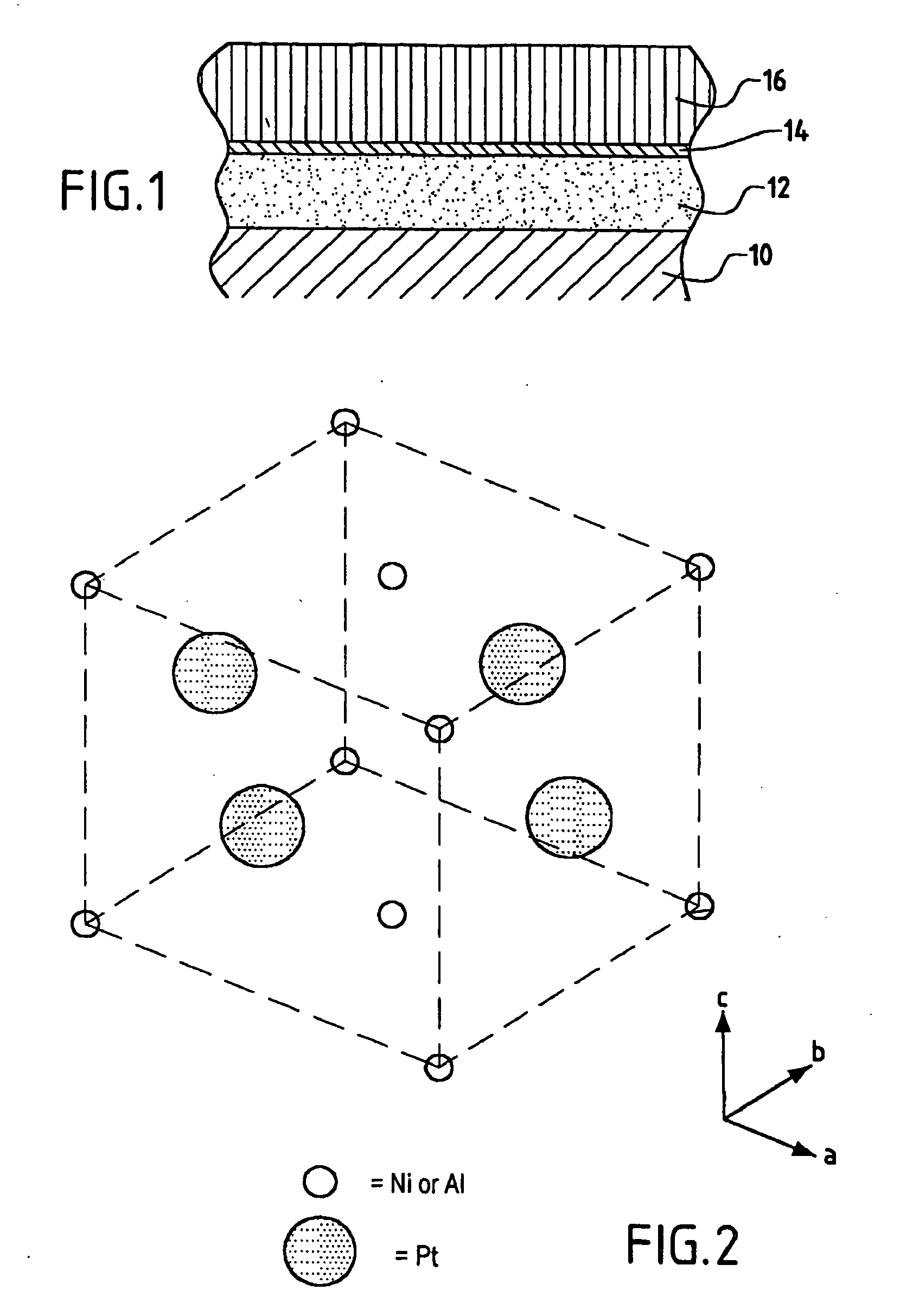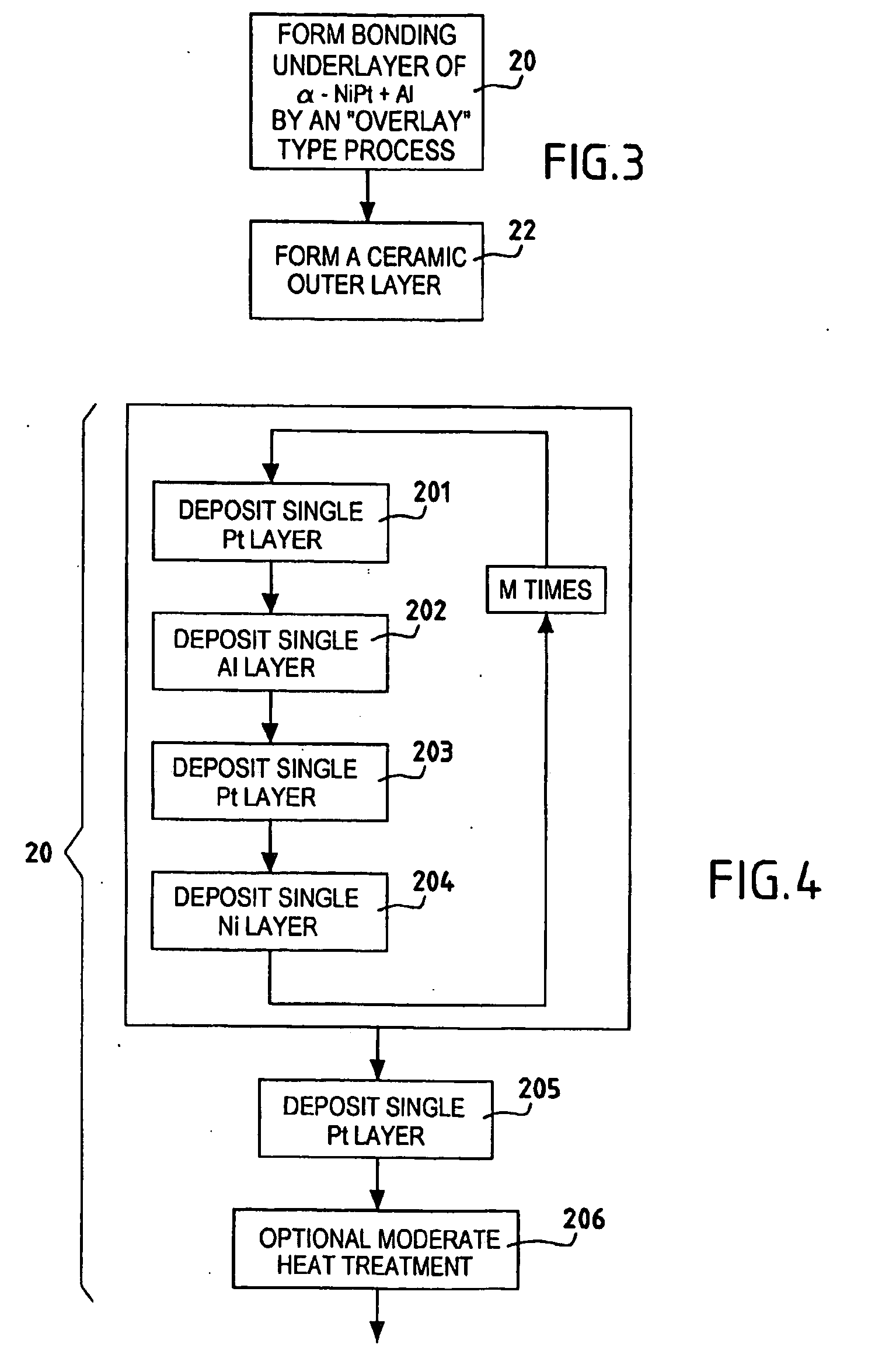A method of forming a thermal protective coating on a super alloy metal substrate
a technology of super alloy metal and protective coating, which is applied in the direction of chemical vapor deposition coating, blade accessories, machines/engines, etc., can solve the problems affecting adhesion, and achieve the effects of long-term resistance to spalling of ceramic layers, small thickness, and light weigh
- Summary
- Abstract
- Description
- Claims
- Application Information
AI Technical Summary
Benefits of technology
Problems solved by technology
Method used
Image
Examples
example 1
[0092]Metal parts were used made of a single crystal superalloy based on nickel and having the following composition (percentages by weight): 6.5% Co, 7.5% Cr, 5.3% Al, 1.2% Ti, 8% Ta, 2% Mo, 5.5% W, with the balance being Ni.
[0093]Parts were provided with alternating layers of platinum and aluminum by a physical vapor deposition process using cathode sputtering, in application of the second implementation described above (FIG. 7). 84 single layers of platinum were deposited each having a thickness of 30 nm, alternating with 83 single layers of aluminum each having a thickness of 66 nm.
[0094]Temperature was raised to 700° C. for 2 h in order to trigger an exothermal reaction between the single layers, causing a PtAl2 type platinum and aluminum intermetallic compound to be formed in a layer having a thickness of 7.5 μm.
[0095]Thereafter, a ceramic outer layer of zirconia ZrO2 stabilized with yttrium oxide Y2O3 (representing 8% by weight) was deposited. Deposition took place as describ...
example 2
[0096]The procedure was the same as in Example 1, but the number of single layers of platinum and aluminum was limited so as to obtain, after exothermal reaction between them, a PtAl2 type intermetallic compound in a layer having a thickness equal to about 2.5 μm.
[0097]The microphotograph of FIG. 8 shows the results that were obtained.
example 3
For Comparison
[0098]On substrates having the same composition as that of Examples 1 and 2, a bonding underlayer was formed by electro-deposition of a platinum layer and by vapor aluminization so as to obtain, in a manner that is known in the prior art, a bonding underlayer corresponding to a platinum-enriched P-type phase of the Ni—Al binary phase diagram. The thickness of the bonding underlayer was 60 μm. Thereafter, a ceramic outer layer was formed as described in Example 1.
[0099]Tests for ability to withstand thermal cycling in an oxidizing medium (air) were performed on the parts A, B, and C as obtained in Examples 1, 2, and 3 respectively, each cycle comprising a rapid temperature rise up to 1100° C. which was maintained for 1 h, after which there was a return to ambient temperature which was maintained for 15 minutes (min).
[0100]As shown in FIG. 9, the parts B withstood 624 cycles in satisfactory manner, which is a very remarkable result given the very small thickness (2.5 μm)...
PUM
| Property | Measurement | Unit |
|---|---|---|
| temperature | aaaaa | aaaaa |
| thickness | aaaaa | aaaaa |
| temperature | aaaaa | aaaaa |
Abstract
Description
Claims
Application Information
 Login to View More
Login to View More - R&D
- Intellectual Property
- Life Sciences
- Materials
- Tech Scout
- Unparalleled Data Quality
- Higher Quality Content
- 60% Fewer Hallucinations
Browse by: Latest US Patents, China's latest patents, Technical Efficacy Thesaurus, Application Domain, Technology Topic, Popular Technical Reports.
© 2025 PatSnap. All rights reserved.Legal|Privacy policy|Modern Slavery Act Transparency Statement|Sitemap|About US| Contact US: help@patsnap.com



